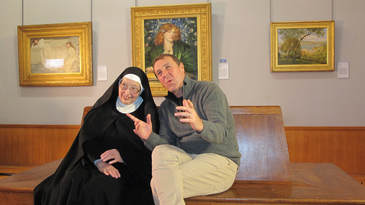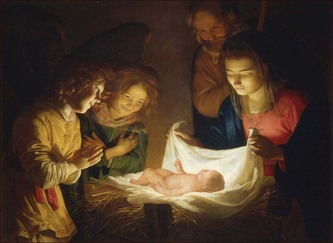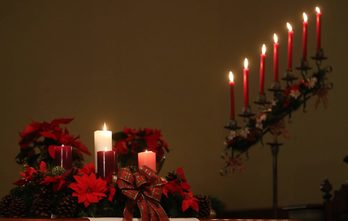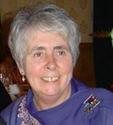
I’m intrigued by this because Sister Wendy began her religious life as a member of my community, the Sisters of Notre Dame. I’ve always known about her, about her struggles to find her true vocation which did not seem to be in teaching, her attempts to find a place where she could live out her desire for prayer and contemplation and her final settling to live in a caravan in the grounds of Quidenham Carmel in Norfolk. We have all sorts of stories about her. As a young sister I visited Quidenham with some friends for evening prayer. We hoped Sr Wendy would be there and notice us, maybe even talk to us, but she came and went without a sideways glance.
In a way we sisters have always felt she belonged to us. We’ve always been interested in her and marvelled at how she fulfilled her teaching vocation in an unusual way. She struggled with teaching until her health broke down but her abandoning the classroom hasn’t meant abandoning teaching which she continues to do through her programmes that are now available on youtube and her books, written because she needed an income. However, I think of her as irrepressible. Her desire for silence, prayer and contemplation was true no doubt and she spent hours, days, months and years in this pursuit. But some people just cannot avoid coming to the attention of the public. It’s as though their spirit cannot be dampened and needs a conduit to express itself.
Thomas Merton was like this. He entered a Trappist Monastery, a monastery of strict silence and prayer but this wasn’t enough for him and he got permission to stay in a hermitage a mile removed from the main monastery buildings. He wrote about silence and obedience but struggled with them. He wrote prodigiously, entertained visitors and got involved in the peace movement as well as interfaith dialogue. He died fifty years ago this December and many commentators wonder about what his future would have been if he had not died so young. Would he have left and got involved actively in social justice issues, particularly non- violent peace making? Would he have become Buddhist? He died in Bangkok and on the way there he stopped off at Polonnaruwa in Sri Lanka, with its large rock carved statues of the Buddha. He is reported as saying he was knocked over with a rush of relief and thankfulness at the obvious clarity of the figures. He wrote in his journal “I was suddenly, almost forcibly, jerked clean of the habitual, half – tied vision of things, and an inner clearness, clarity, as if exploding from the robes themselves, became evident and obvious”. Thomas Merton lives on through his writings and talks. There was no dampening of his spirit, no stopping him communicating and speaking to the world in spite of his great desire for a hidden and silent life.
In Assisi I was amused that the casket containing the remains of St Francis was bound by chains and padlocks as though the spirit of Francis was bursting to escape. No doubt the casket’s chained because people tried to steal the remains but it did give the impression of wanting to contain Francis whose spirit is everywhere in Assisi. It’s easy to imagine coming across him wherever you turn. The spirit of Francis is very much alive and seen in the present Pope who took Francis as his name, explaining to journalists that he chose the name because Francis of Assisi was “the man of poverty, the man of peace, the man who lives and protects creation, all themes of his pontificate. Please God the irrepressibility of this spirit will lead the world into a better space in the coming year.




 RSS Feed
RSS Feed
